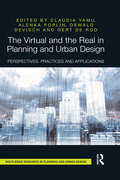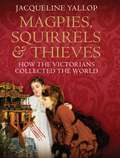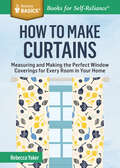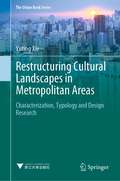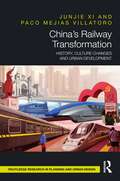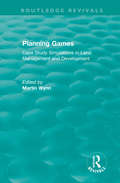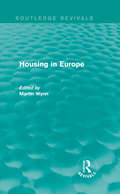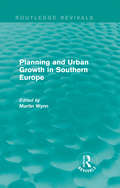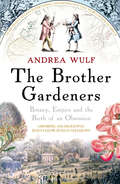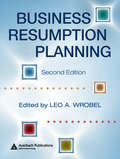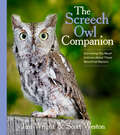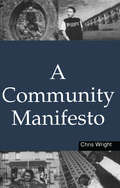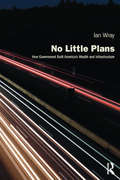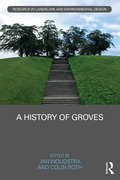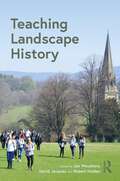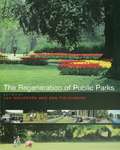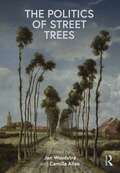- Table View
- List View
The Virtual and the Real in Planning and Urban Design: Perspectives, Practices and Applications
by Claudia Yamu Alenka Poplin Oswald Devisch Gert De RooThe Virtual and the Real in Planning and Urban Design: Perspectives, Practices and Applications explores the merging relationship between physical and virtual spaces in planning and urban design. Technological advances such as smart sensors, interactive screens, locative media and evolving computation software have impacted the ways in which people experience, explore, interact with and create these complex spaces. This book draws together a broad range of interdisciplinary researchers in areas such as architecture, urban design, spatial planning, geoinformation science, computer science and psychology to introduce the theories, models, opportunities and uncertainties involved in the interplay between virtual and physical spaces. Using a wide range of international contributors, from the UK, USA, Germany, France, Switzerland, Netherlands and Japan, it provides a framework for assessing how new technology alters our perception of physical space.
Magpies, Squirrels and Thieves: How the Victorians Collected the World
by Jacqueline YallopDuring the Victorian age, British collectors were among the most active, passionate and eccentric in the world. Magpies, Squirrels and Thieves tells the stories of some of the nineteenth century's most intriguing collectors following their perilous journeys across the globe in the hunt for rare and beautiful objects. From art connoisseur John Charles Robinson, to the aristocratic scholar Charlotte Schreiber, who ransacked Europe for treasure, and from London's fashionable Pre-Raphaelite circle to pioneering Orientalists in Beijing, Jacqueline Yallop plunges us into the cut-throat world of the Victorian mania for collecting.
How to Make Curtains: Measuring and Making the Perfect Window Coverings for Every Room in Your Home. A Storey BASICS® Title (Storey Basics)
by Rebecca YakerRebecca Yaker, co-author of the best-selling One-Yard Wonders, offers this complete introduction to making your own curtains, covering everything from measuring to calculating yardage, choosing the best fabrics, sewing your curtains, adding linings, and selecting the right fixtures and hardware for hanging. She includes step-by-step instructions for making five different curtain styles: pleats, eyelets, tab tops, tie tops, and rod pockets.
Restructuring Cultural Landscapes in Metropolitan Areas: Characterization, Typology and Design Research (The Urban Book Series)
by Yuting XieThis book introduces a ten-year-long design research project in the Yangtze River Delta (YRD), China, based on international cooperation studios, design workshops, a Ph.D. thesis, and concrete practice in China, Germany, and the Netherlands. This research adapts the existing methods of Landscape Character Assessment (UK), Historic Cultural Landscape Elements (Germany), and Dutch Polder Typology to mapping, describing, and classifying landscape character areas and types at the three scales of regional, municipal, and local. Furthermore, to connect research with design, we developed a typological approach of generating specific measures for the networked polder landscape. This research bridges the gap of a missing landscape characterization method for the conservation, transformation, and critical reconstruction of historic cultural landscapes in a metropolitan context. The book is intended for graduate students, researchers, and practitioners interested in the topics of cultural landscape in transition, methods for landscape characterization and typology, and a research-by-design approach in interdisciplinary projects of landscape architecture, urbanism, and regional planning.
China’s Railway Transformation: History, Culture Changes and Urban Development
by Junjie Xi Paco Mejias VillatoroThis book investigates China’s railway transformation through history, along with culture changes and urban development. The book begins by looking at the background of China and the history and growth of railway development in China through five key phases, followed by assessing the cultural changes in the railway carriage and exploring how these are linked to social equality and national provisions. The core of this book aims to analyse the Chinese urban transformation through the development of the high-speed rail (HSR) infrastructure in China. Eleven important new HSR stations in mainland China, plus the new Hong Kong West Kowloon Station, have been selected to contextually explore how HSR infrastructures have affected the development of the Chinese urban context. The selected case studies are the stations of Beijing South, Wuhan, Shanghai Hongqiao, Guangzhou South, Xi’an North, Nanjing South, Chengdu East, Tianjin West, Zhengzhou East, Hangzhou East and Hong Kong West Kowloon. All of these were built between 2008 and 2018. In these case studies, the location and the intentions and success of promoting urban development are analysed and assessed. Following this, the book further investigates the peculiarities of the new HSR stations in China in comparison with stations in Europe. An assessment framework is established to evaluate the Chinese case studies comparatively with significant cases in Europe, attending to the urban structure of the area, the architectural quality, the functional diversity and the quality of the public space generated in the surrounding area.
China’s Railway Transformation: History, Culture Changes and Urban Development
by Junjie Xi Paco Mejias VillatoroThis book investigates China’s railway transformation through history, along with culture changes and urban development. The book begins by looking at the background of China and the history and growth of railway development in China through five key phases, followed by assessing the cultural changes in the railway carriage and exploring how these are linked to social equality and national provisions. The core of this book aims to analyse the Chinese urban transformation through the development of the high-speed rail (HSR) infrastructure in China. Eleven important new HSR stations in mainland China, plus the new Hong Kong West Kowloon Station, have been selected to contextually explore how HSR infrastructures have affected the development of the Chinese urban context. The selected case studies are the stations of Beijing South, Wuhan, Shanghai Hongqiao, Guangzhou South, Xi’an North, Nanjing South, Chengdu East, Tianjin West, Zhengzhou East, Hangzhou East and Hong Kong West Kowloon. All of these were built between 2008 and 2018. In these case studies, the location and the intentions and success of promoting urban development are analysed and assessed. Following this, the book further investigates the peculiarities of the new HSR stations in China in comparison with stations in Europe. An assessment framework is established to evaluate the Chinese case studies comparatively with significant cases in Europe, attending to the urban structure of the area, the architectural quality, the functional diversity and the quality of the public space generated in the surrounding area.
Routledge Revivals: Case Study Simulations in Land Management and Development (Routledge Revivals)
by Martin WynnFirst published in 1985, this book presents seven games for use in the teaching and study of planning, urban studies or land administration. These simulations are all built on researched case studies and deal with a number of critical planning and developmental issues; for each one the book provides full operational instructions and all gaming materials required. The games in this volume cover a number of scenarios, including the design of a mixed retail, social and service centre in a new city, new development in a run-down inner city area, rehabilitation or renewal of housing, tourist development in the Mediterranean and a new cross-town motorway in a major north American city. In addition, sets of guidelines for those wishing to design and operate their own case study simulations are also included. This book will be a valuable resource for students of town planning or urban development who are keen to gain ‘hands-on’ experience of using the professional skills they have acquired on their courses.
Routledge Revivals: Case Study Simulations in Land Management and Development (Routledge Revivals)
by Martin WynnFirst published in 1985, this book presents seven games for use in the teaching and study of planning, urban studies or land administration. These simulations are all built on researched case studies and deal with a number of critical planning and developmental issues; for each one the book provides full operational instructions and all gaming materials required. The games in this volume cover a number of scenarios, including the design of a mixed retail, social and service centre in a new city, new development in a run-down inner city area, rehabilitation or renewal of housing, tourist development in the Mediterranean and a new cross-town motorway in a major north American city. In addition, sets of guidelines for those wishing to design and operate their own case study simulations are also included. This book will be a valuable resource for students of town planning or urban development who are keen to gain ‘hands-on’ experience of using the professional skills they have acquired on their courses.
Routledge Revivals: Housing in Europe (Routledge Revivals)
by Martin WynnFirst published in 1984, this book presents a survey of housing problems in various European countries and how individual states have responded. Each chapter begins by surveying the problem in each country since the Second World War, before going on to outline the roles fulfilled by national housing agencies and local authorities, as well as assessing the impact of housing policies on society and on the physical shape of cities. It considers whether housing policies have succeeded or failed and how the ‘housing problem’ has changed over time. Each chapter draws out lessons that can be learned for the future from each country’s past handling of the problem. This book will be a useful reference for those interested in housing, including planners, geographers, economists, sociologists or policy-makers.
Routledge Revivals: Housing in Europe (Routledge Revivals)
by Martin WynnFirst published in 1984, this book presents a survey of housing problems in various European countries and how individual states have responded. Each chapter begins by surveying the problem in each country since the Second World War, before going on to outline the roles fulfilled by national housing agencies and local authorities, as well as assessing the impact of housing policies on society and on the physical shape of cities. It considers whether housing policies have succeeded or failed and how the ‘housing problem’ has changed over time. Each chapter draws out lessons that can be learned for the future from each country’s past handling of the problem. This book will be a useful reference for those interested in housing, including planners, geographers, economists, sociologists or policy-makers.
Routledge Revivals: Planning and Urban Growth in Southern Europe (Routledge Revivals)
by Martin WynnFirst published in 1984, this book addresses key questions about the pattern of urban development in Southern Europe and the mechanisms employed to control and regulate this development in individual countries. It examines five countries – Greece, Italy, Portugal, Spain and Turkey – that have experienced different scales and rates of urbanization and industrialization. It identifies common problems arising from these processes, as well as the successes and failures of the planning policies employed to regulate development. This book will be of great value to geographers interested in Southern Europe and urban and regional planners interested in comparative patterns of development.
Routledge Revivals: Planning and Urban Growth in Southern Europe (Routledge Revivals)
by Martin WynnFirst published in 1984, this book addresses key questions about the pattern of urban development in Southern Europe and the mechanisms employed to control and regulate this development in individual countries. It examines five countries – Greece, Italy, Portugal, Spain and Turkey – that have experienced different scales and rates of urbanization and industrialization. It identifies common problems arising from these processes, as well as the successes and failures of the planning policies employed to regulate development. This book will be of great value to geographers interested in Southern Europe and urban and regional planners interested in comparative patterns of development.
The Brother Gardeners: Botany, Empire and the Birth of an Obsession
by Andrea WulfOne January morning in 1734, cloth merchant Peter Collinson hurried down to the docks at London's Custom House to collect cargo just arrived from John Bartram in the American colonies. But it was not bales of cotton that awaited him, but plants and seeds...Over the next forty years, Bartram would send hundreds of American species to England, where Collinson was one of a handful of men who would foster a national obsession and change the gardens of Britain forever: Philip Miller, author of the bestselling Gardeners Dictionary; the Swede Carl Linnaeus, whose standardised botanical nomenclature popularised botany; the botanist-adventurer Joseph Banks and his colleague Daniel Solander who both explored the strange flora of Tahiti and Australia on Captain Cook's Endeavour.This is the story of these men - friends, rivals, enemies, united by a passion for plants. Set against the backdrop of the emerging empire and the uncharted world beyond, The Brother Gardeners tells the story how Britain became a nation of gardeners.
Business Resumption Planning
by Leo A. WrobelOffering hundreds of tips, templates, checklists, and pointers to information in the public domain, Business Resumption Planning, Second Edition assists you in creating a rock solid recovery plan for any size organization. It provides the information you need in order to coordinate first responders to meet any disaster scenario head on, whet
The Screech Owl Companion: Everything You Need to Know about These Beneficial Raptors
by Jim Wright Scott WestonThis must-read for birders features a complete guide to attracting, understanding, and protecting owls. The call of an owl evokes mystery; seeing one in the wild inspires wonder. Of the top ten birds people hope to see, three are owls. Although they may be out of sight, owls are widespread throughout North America—and screech owls are the most likely to make their homes near humans. In this book, experts Jim Wright and Scott Weston show you how to attract them to nest in your yard, year after year.The Screech Owl Companion introduces screech owls, show how to distinguish them from other species, shares fun lore and legend, and provides step-by-step instructions for making your yard screech ready. You&’ll learn how to build a nest box and install a simple nest cam that you can monitor from your cell phone to watch when owls move in, lay eggs, and hatch.
A Community Manifesto
by Chris WrightCivilizations fail when they become trapped in a way of looking at the world that no longer works. For many, globalization is pushing us to the edge of disaster - an onward march of blinkered vision, encouraging passivity, moral blindness and a culture of dependency.A Community Manifesto is an elegantly written polemic offering a new way of looking at our social, cultural and economic realities. Tackling the crucial dimensions of personal responsibility, consensus and community, it shows how we can find a new language through which we can reinvigorate our individual and social lives, developing the resourcefulness we need but which proves so difficult to cultivate. The vision it presents is persuasive and very timely - only by building community can human society evolve and progress.
A Community Manifesto
by Chris WrightCivilizations fail when they become trapped in a way of looking at the world that no longer works. For many, globalization is pushing us to the edge of disaster - an onward march of blinkered vision, encouraging passivity, moral blindness and a culture of dependency.A Community Manifesto is an elegantly written polemic offering a new way of looking at our social, cultural and economic realities. Tackling the crucial dimensions of personal responsibility, consensus and community, it shows how we can find a new language through which we can reinvigorate our individual and social lives, developing the resourcefulness we need but which proves so difficult to cultivate. The vision it presents is persuasive and very timely - only by building community can human society evolve and progress.
Go Gently: Actionable Steps to Nurture Yourself and the Planet
by Bonnie WrightAn inspiring and approachable tip-filled guide to changing your habits, living more sustainably, and taking action, by Greenpeace ambassador Bonnie Wright (Ginny Weasley in the Harry Potter movies)Go Gently is a practical guide for sustainability at home that offers simple, tangible steps towards reducing our environmental impact by looking at what we consume and the waste we create, as well as how to take action for environmental change. The title reflects Bonnie's belief that the best way to change our planet and ourselves is through a gentle approach, rather than a judgmental one. This is a book of do's rather than don'ts. Going through every room in her home, Bonnie helps us assess which products are sustainable, and offers alternatives for those that are not. She shares recipes to avoid food waste, homemade self-care products to avoid packaging, small space friendly gardening ideas and a template for creating your own compost system. Finally, there are exercises and meditation prompts to keep you energised, as well as tips on how to get involved in wider community activism.
No Little Plans: How Government Built America’s Wealth and Infrastructure (Planning, History and Environment Series)
by Ian WrayIs planning for America anathema to the pursuit of life, liberty and happiness? Is it true, as ideologues like Friedrich Von Hayek, Milton Friedman, and Ayn Rand have claimed, that planning leads to dictatorship, that the state is wholly destructive, and that prosperity is owed entirely to the workings of a free market? To answer these questions Ian Wray’s book goes in search of an America shaped by government, plans and bureaucrats, not by businesses, bankers and shareholders. He demonstrates that government plans did not damage American wealth. On the contrary, they built it, and in the most profound ways. In three parts, the book is an intellectual roller coaster. Part I takes the reader downhill, examining the rise and fall of rational planning, and looks at the converging bands of planning critics, led on the right by the Chicago School of Economics, on the left by the rise of conservation and the ‘counterculture’, and two brilliantly iconoclastic writers – Jane Jacobs and Rachel Carson. In Part II, eight case studies take us from the trans-continental railroads through the national parks, the Federal dams and hydropower schemes, the wartime arsenal of democracy, to the postwar interstate highways, planning for New York, the moon shot and the creation of the internet. These are stories of immense government achievement. Part III looks at what might lie ahead, reflecting on a huge irony: the ideology which underpins the economic and political rise of Asia (by which America now feels so threatened) echoes the pragmatic plans and actions which once secured America’s rise to globalism.
No Little Plans: How Government Built America’s Wealth and Infrastructure (Planning, History and Environment Series)
by Ian WrayIs planning for America anathema to the pursuit of life, liberty and happiness? Is it true, as ideologues like Friedrich Von Hayek, Milton Friedman, and Ayn Rand have claimed, that planning leads to dictatorship, that the state is wholly destructive, and that prosperity is owed entirely to the workings of a free market? To answer these questions Ian Wray’s book goes in search of an America shaped by government, plans and bureaucrats, not by businesses, bankers and shareholders. He demonstrates that government plans did not damage American wealth. On the contrary, they built it, and in the most profound ways. In three parts, the book is an intellectual roller coaster. Part I takes the reader downhill, examining the rise and fall of rational planning, and looks at the converging bands of planning critics, led on the right by the Chicago School of Economics, on the left by the rise of conservation and the ‘counterculture’, and two brilliantly iconoclastic writers – Jane Jacobs and Rachel Carson. In Part II, eight case studies take us from the trans-continental railroads through the national parks, the Federal dams and hydropower schemes, the wartime arsenal of democracy, to the postwar interstate highways, planning for New York, the moon shot and the creation of the internet. These are stories of immense government achievement. Part III looks at what might lie ahead, reflecting on a huge irony: the ideology which underpins the economic and political rise of Asia (by which America now feels so threatened) echoes the pragmatic plans and actions which once secured America’s rise to globalism.
A History of Groves (Routledge Research in Landscape and Environmental Design)
by Jan Woudstra Colin RothThe grove, a grouping of trees, intentionally cultivated or found growing wild, has a long diverse history entwined with human settlement, rural practices and the culture and politics of cities. A grove can be a memorial, a place of learning, a site of poetic retreat and philosophy or political encampment, a public park or theatre, a place of hidden pleasures, a symbol of a vanished forest ecology, or a place of gods or other spirits. Yet groves are largely absent from our contemporary vocabulary and rarely included in today’s landscape practice, whether urban or rural. Groves are both literal and metaphorical manifestations, ways of defining spaces and ecologies in our cultural life. Since they can add meaning to urban forms and ecologies and contribute meaningfully to the significance of place, critical examination is long overdue. The editors have taken care to ensure that the text is accessible to the general reader as well as specialists.
A History of Groves (Routledge Research in Landscape and Environmental Design)
by Jan Woudstra Colin RothThe grove, a grouping of trees, intentionally cultivated or found growing wild, has a long diverse history entwined with human settlement, rural practices and the culture and politics of cities. A grove can be a memorial, a place of learning, a site of poetic retreat and philosophy or political encampment, a public park or theatre, a place of hidden pleasures, a symbol of a vanished forest ecology, or a place of gods or other spirits. Yet groves are largely absent from our contemporary vocabulary and rarely included in today’s landscape practice, whether urban or rural. Groves are both literal and metaphorical manifestations, ways of defining spaces and ecologies in our cultural life. Since they can add meaning to urban forms and ecologies and contribute meaningfully to the significance of place, critical examination is long overdue. The editors have taken care to ensure that the text is accessible to the general reader as well as specialists.
Teaching Landscape History
by Jan Woudstra David JacquesLandscape history is changing in content and style to address the issues of today. Experienced teachers and authors on the history of gardens and landscapes come together in this new volume to share ideas on the future of teaching history in departments of landscape architecture, archaeology, geography and allied subjects. Design history remains important, but this volume brings to the fore the increasing importance of environmental history, economic history, landscape history, cultural landscapes, environmental justice and decolonisation, ideas of sustainability and climate change amelioration, which may all be useful in serving the needs of a widening range of students in an increasingly complex world. The main themes include: what history should we narrate in the education of landscape architects? how can we recognise counter-narratives and our own bias? how should we engage the students in the history of their chosen profession? how can designers and researchers be persuaded of the relevance of history teaching to theory and practice? and what resources do we need to develop teaching of landscape histories? This book will be of interest to anyone teaching courses on landscape architecture, urban design, horticulture, garden design, architectural history, cultural geography and more.
The Regeneration of Public Parks
by Jan Woudstra Ken FieldhouseThe Urban Parks Programme, financed by the Heritage Lottery Fund, has sparked a new enthusiasm for the regeneration of Britain's parks. This unique reference book gives a valuable overview of all the elements of public park design. It emphasizes our parks' diversity and richness, and offers practical guidance as to their renovation and future care. It is essential reading for all those involved in the design, upkeep and regeneration of public parks.
The Politics of Street Trees
by Jan Woudstra Camilla AllenThis book focuses on the politics of street trees and the institutions, actors and processes that govern their planning, planting and maintenance. This is an innovative approach which is particularly important in the context of mounting environmental and societal challenges and reveals a huge amount about the nature of modern life, social change and political conflict. The work first provides different historical perspectives on street trees and politics, celebrating diversity in different cultures. A second section discusses street tree values, policy and management, addressing more contemporary issues of their significance and contribution to our environment, both physically and philosophically. It explores cultural idiosyncrasies and those from the point of view of political economy, particularly challenging the neo-liberal perspectives that continue to dominate political narratives. The final section provides case studies of community engagement, civil action and governance. International case studies bring together contrasting approaches in areas with diverging political directions or intentions, the constraints of laws and the importance of people power. By pursuing an interdisciplinary approach this book produces an information base for academics, practitioners, politicians and activists alike, thus contributing to a fairer political debate that helps to promote more democratic environments that are sustainable, equitable, comfortable and healthier.
